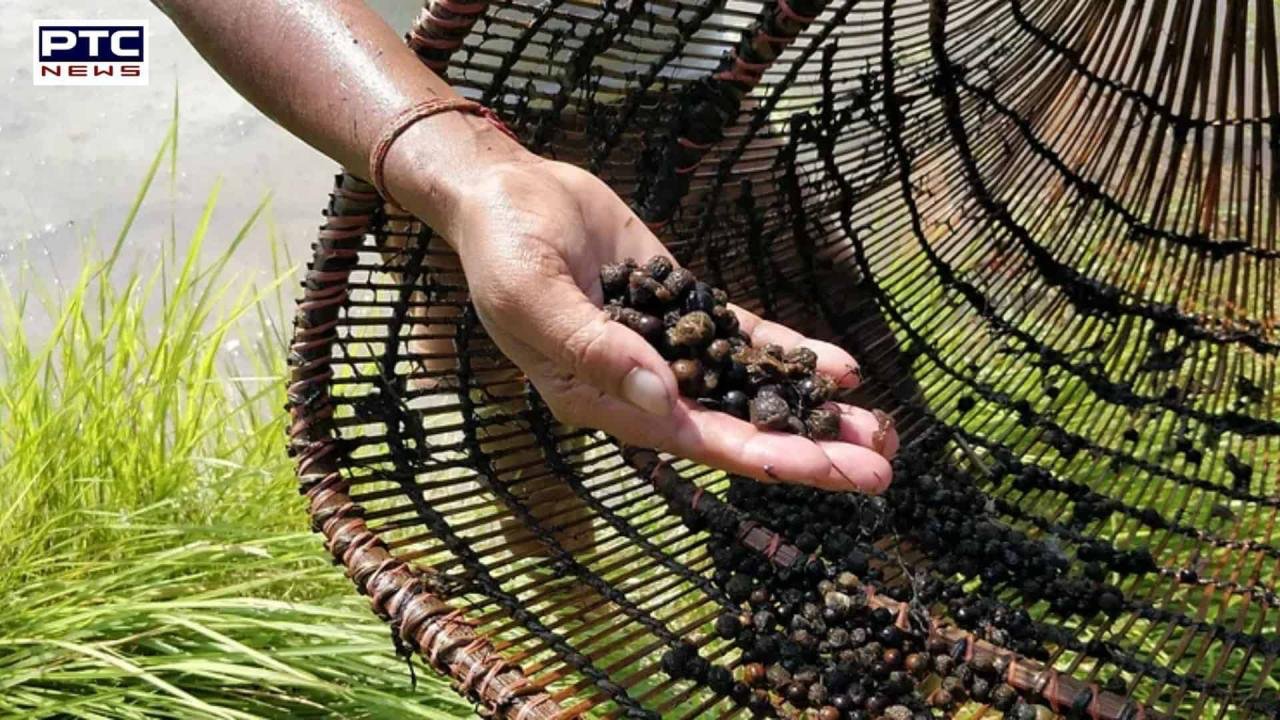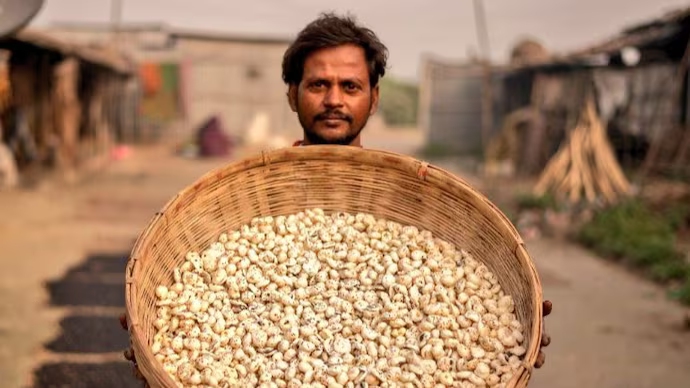Euryale ferox, commonly known as fox nuts, lotus seeds or makhana, has quickly become a prized crop around India. Bihar alone produces
, a highly nutritious seed sought after for its protein, fibre, and vitamin content. However, traditional harvesting methods have long been labour-intensive, inefficient, and hazardous. Fishermen and farmers dive into deep, muddy ponds — often as deep as eight to 12 feet — for hours to collect the seeds, risking injuries and infections.
Recognising these issues, Dr Manoj Kumar, a senior scientist at the National Research Centre for Makhana (NRCM), has figured out a way to turn makhana cultivation into a more sustainable and profitable agricultural practice, benefiting thousands of farmers in the region.
For generations, families like Phool Dev Shahni’s in Darbhanga, Bihar, have relied on traditional makhana farming methods. Shahni would spend seven to eight hours every day underwater, surfacing every eight to 10 minutes. Sharp thorns on the plants caused frequent cuts, while the muddy water led to skin infections. This backbreaking process discouraged younger generations from continuing the practice.
Advertisement
Makhana cultivation also required specific conditions — shallow, low-lying water bodies with depths ranging from 30 cm to over 300 cm. Frequent often wiped out crops, leaving farmers with no returns. Meanwhile, rice farming, the region’s fallback option, offered meagre profits and an unsustainable livelihood.
Dr Manoj Kumar spent a decade researching ways to make makhana farming more efficient, sustainable, and less labour-intensive. One of his breakthroughs was proving that makhana could thrive in water as shallow as 30 cm, contrary to the traditional belief that five to six feet was necessary. This discovery allowed farmers to grow makhana like any other crop in fields, reducing dependence on deep, flood-prone ponds.
Advertisement
Dr Kumar also developed a high-yielding variety of makhana called ‘Swarna Vaidehi’, a high-yielding variety of makhana. This variety adapted well to local conditions and significantly increased productivity. Additionally, techniques like nursery raising (growing seedlings separately before transplanting) and line planting (organised sowing in rows) were introduced. These methods reduced seed requirements and improved yields, making farming more efficient.
Floods have long been a major threat to makhana farming, often destroying entire crops. Dr Kumar tackled this issue by introducing net fencing, a simple yet effective solution. It involves installing mesh barriers around makhana fields to protect crops from being washed away by floodwaters.

Floods threaten makhana crops, but innovative solutions like net fencing provide protection.
Image Courtesy PTC NEWS
This innovation made it possible to cultivate makhana in areas previously considered too risky. With the combination of shallow water cultivation and flood protection, Dr Kumar’s methods have forever changed makhana farming in Bihar.
Advertisement
Dhirendra Kumar, a farmer from Belwara village in Darbhanga, is a prime example of the benefits of Dr Kumar’s innovations. For years, Dhirendra grew rice, earning only Rs 20,000 to 25,000 per hectare. Frequent floods often wiped out his crops, leaving him disheartened.
In 2020, Dhirendra attended a ‘Farmer-Scientist Interaction cum Field Day’ organised by NRCM, where he learned about makhana farming. Inspired by the crop’s potential, he decided to switch from rice to makhana cultivation on his three-hectare plot, thus becoming a key case study of Dr Kumar. With technical guidance from NRCM and Krishi Vigyan Kendra (KVK), he planted Swarna Vaidehi seeds in a nursery and later transplanted them into his fields.
Despite initial challenges with nutrient management, Dhirendra harvested 48 quintals of makhana in the first season, earning a gross income of Rs 5.28 lakhs and a net income of Rs 2.58 lakhs. This was a dramatic improvement compared to the Rs 60,000 he earned from on the same land in previous years.
Advertisement
One technique that further boosted Dhirendra’s success was polythene lining to prevent water loss from lateral seepage. Traditionally, makhana farmers struggled to maintain consistent water levels in their fields, especially during the dry pre-monsoon months (March to May).
Dr Kumar recommended using 100-micron polythene sheets to seal the bunds (field barriers). This simple, low-cost solution minimised water seepage, reducing the need for frequent irrigation. As a result, Dhirendra saved both water and costs, making his farming process more sustainable.

Farmers are increasing income and yields with improved makhana farming methods.
Image courtesy India Today
Just like Dhirendra, many farmers across Bihar have embraced Dr Kumar’s innovations, transforming their livelihoods. With flood-resistant practices, shallow water cultivation, and like polythene bund lining, makhana farming has become a viable and profitable option for farmers in the region.
The Swarna Vaidehi variety’s high yield and the growing global demand for makhana have opened new markets for farmers. The GI tag for Mithila makhana ensures premium prices for high-quality produce, further boosting farmer incomes.
Unlike water-intensive crops like rice, makhana thrives in shallow water and is better suited to Bihar’s unpredictable weather, reducing the risk of crop failure. This makes it an attractive option for young farmers who had been discouraged by the the low returns from conventional farming.
Edited by Khushi Arora
Recognising these issues, Dr Manoj Kumar, a senior scientist at the National Research Centre for Makhana (NRCM), has figured out a way to turn makhana cultivation into a more sustainable and profitable agricultural practice, benefiting thousands of farmers in the region.
Perils of an inefficient makhana harvesting process
For generations, families like Phool Dev Shahni’s in Darbhanga, Bihar, have relied on traditional makhana farming methods. Shahni would spend seven to eight hours every day underwater, surfacing every eight to 10 minutes. Sharp thorns on the plants caused frequent cuts, while the muddy water led to skin infections. This backbreaking process discouraged younger generations from continuing the practice.
Advertisement
Makhana cultivation also required specific conditions — shallow, low-lying water bodies with depths ranging from 30 cm to over 300 cm. Frequent often wiped out crops, leaving farmers with no returns. Meanwhile, rice farming, the region’s fallback option, offered meagre profits and an unsustainable livelihood.
A vision to change the face of makhana cultivation
Dr Manoj Kumar spent a decade researching ways to make makhana farming more efficient, sustainable, and less labour-intensive. One of his breakthroughs was proving that makhana could thrive in water as shallow as 30 cm, contrary to the traditional belief that five to six feet was necessary. This discovery allowed farmers to grow makhana like any other crop in fields, reducing dependence on deep, flood-prone ponds.
Advertisement
Dr Kumar also developed a high-yielding variety of makhana called ‘Swarna Vaidehi’, a high-yielding variety of makhana. This variety adapted well to local conditions and significantly increased productivity. Additionally, techniques like nursery raising (growing seedlings separately before transplanting) and line planting (organised sowing in rows) were introduced. These methods reduced seed requirements and improved yields, making farming more efficient.
Overcoming the flood challenge with innovative net fencing
Floods have long been a major threat to makhana farming, often destroying entire crops. Dr Kumar tackled this issue by introducing net fencing, a simple yet effective solution. It involves installing mesh barriers around makhana fields to protect crops from being washed away by floodwaters.

Floods threaten makhana crops, but innovative solutions like net fencing provide protection.
Image Courtesy PTC NEWS
This innovation made it possible to cultivate makhana in areas previously considered too risky. With the combination of shallow water cultivation and flood protection, Dr Kumar’s methods have forever changed makhana farming in Bihar.
Advertisement
A farmer’s story of reaping rewards with makhana farming
Dhirendra Kumar, a farmer from Belwara village in Darbhanga, is a prime example of the benefits of Dr Kumar’s innovations. For years, Dhirendra grew rice, earning only Rs 20,000 to 25,000 per hectare. Frequent floods often wiped out his crops, leaving him disheartened.
In 2020, Dhirendra attended a ‘Farmer-Scientist Interaction cum Field Day’ organised by NRCM, where he learned about makhana farming. Inspired by the crop’s potential, he decided to switch from rice to makhana cultivation on his three-hectare plot, thus becoming a key case study of Dr Kumar. With technical guidance from NRCM and Krishi Vigyan Kendra (KVK), he planted Swarna Vaidehi seeds in a nursery and later transplanted them into his fields.
Despite initial challenges with nutrient management, Dhirendra harvested 48 quintals of makhana in the first season, earning a gross income of Rs 5.28 lakhs and a net income of Rs 2.58 lakhs. This was a dramatic improvement compared to the Rs 60,000 he earned from on the same land in previous years.
Advertisement
Polythene lining as a simple solution to water management
One technique that further boosted Dhirendra’s success was polythene lining to prevent water loss from lateral seepage. Traditionally, makhana farmers struggled to maintain consistent water levels in their fields, especially during the dry pre-monsoon months (March to May).
Dr Kumar recommended using 100-micron polythene sheets to seal the bunds (field barriers). This simple, low-cost solution minimised water seepage, reducing the need for frequent irrigation. As a result, Dhirendra saved both water and costs, making his farming process more sustainable.

Farmers are increasing income and yields with improved makhana farming methods.
Image courtesy India Today
A game-changer for Bihar’s farmers
Just like Dhirendra, many farmers across Bihar have embraced Dr Kumar’s innovations, transforming their livelihoods. With flood-resistant practices, shallow water cultivation, and like polythene bund lining, makhana farming has become a viable and profitable option for farmers in the region.
The Swarna Vaidehi variety’s high yield and the growing global demand for makhana have opened new markets for farmers. The GI tag for Mithila makhana ensures premium prices for high-quality produce, further boosting farmer incomes.
Unlike water-intensive crops like rice, makhana thrives in shallow water and is better suited to Bihar’s unpredictable weather, reducing the risk of crop failure. This makes it an attractive option for young farmers who had been discouraged by the the low returns from conventional farming.
Edited by Khushi Arora
